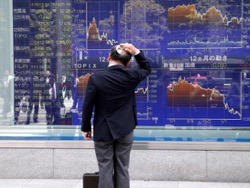
We are not just at the point of change of financial cycles, when the fall follows growth, and in a situation where we need to change the model of functioning of the economy.
Epic fall of the financial markets in November 2008 marked the beginning of the great recession and pushed to the surface many important economic, financial and social processes. It would be right to try to logically organize a number of seemingly disparate events: the fall in the rate of economic growth, despite eight years of total stimulus around the world, the rapid development of new technologies, still, however, not led to proryvnom growth of labour productivity surge “nihilistic”, and other populist anti-globalization sentiment among the electorate in the most unexpected places on the world map and a marked destabilization of the archaic political regimes primarily in the middle East.
At least the coincidence of these phenomena in time, and the fact that the world economy for too long is “unusual” condition, tells us that in 2008 we are faced not just with the crisis is cyclical in nature, but with a systemic phenomenon, the beginning of a great transformation. Leaving aside the phenomenon of the social plan, talk about the economic component of the current situation.
Incentives without growth
The pace of global growth after the peak of the financial crisis of 2008 dropped significantly. This is especially noticeable on the example of emerging markets, where growth declined from about 7% in 2010 to 4% on average in recent years. GDP growth “the main engine” for global economic growth — China is at the peak of the “boom of the BRICS” in mid-2007 reached almost 15%, now less than 7%, and the government requires fairly intensive measures to keep him in this area.
In this same time period, average GDP growth fell first half against the pre-crisis times, and then moved into a prolonged phase of recession. Slightly less difficult demonstrates, the economy of Brazil, another member of the club of the BRICS, only India’s economy like he’s still growing quite rapidly.
Global economic growth slowed from 5% in 2003-2007 to less than 3% currently. The U.S. economy cannot achieve a growth rate of about 3% is considered typical for healthy States: the fed expects U.S. GDP growth in 2016 at 1.8%. That is especially surprising, considering the “hype” in the field of innovation, the growth rate of labor productivity has also declined in the U.S., and in China and in other countries. From 1995 to 2005 the average growth rate of labour productivity in the US was 2.2% per year from 2005 to 2015 — just 0.9%. The productivity growth in China fell below 4% per year, although the peak of the crisis, he stayed consistently above 6% and exceeded 10% in 2006.
How could this happen with the active stimulation of the world economy, in which the world seems an epidemic is caught in a liquidity trap with negative rates already in a number of economies? Obviously, we are not just a point — how quite a serious period of time can be called point — shift cycles, financial and economic nature, when the fall follows growth as a result over-investment or investing in the wrong items (or both), and in a situation where it must change the model of functioning of the economy.
Something similar happened during the formation of the gold standard in the late nineteenth century, at the time of its abolition during the great depression and the appearance of the Bretton woods system after the Second world war, then the fall of Bretton woods and the advent of floating currencies in the early 1970s and finally now during the great recession and overcome its consequences. By coincidence — coincidence? — the circumstances between these reference points in history took place around 35 or a little more years. If you look a little closer, each of these events gave rise to a number of related or resulting from trends in the monetary, technological, social and even economic theory, but also in the system of relations between society and business.
Change large economic cycles today, in all likelihood, significantly slowed the unprecedented stimulus policies, most notably, the major Central banks in the world. The purpose of this incentive policy: to support the traditional driver of growth — credit and to enable more or less smoothly to conduct the necessary deleveraging in those segments where it is needed.
Were you able to achieve these goals to date? The answer to this question is different for different segments of the economy and for individual countries. Nevertheless, the overall result is that only developed economies, the debt of the private sector by the end of 2014 compared to pre-crisis year of 2007 decreased from 158% to 156% of GDP, in other words, almost unchanged. But the public debt rose from 69% to 104% of GDP. According to McKinsey, in the beginning of the century the total debt in all countries with available statistics, stood at 246% of their combined GDP, or $87 trillion in mid-2014 — 286% of GDP, or $199 trillion constant dollars of 2013. If the rate of growth of non-state debt, but corporate, after the crisis fell almost three times (corporate debt continued to grow due to extremely low maintenance cost), the rate of growth of the national debt has increased by about 40%, nearly half.
The state assumed a significant portion of debt burden of developed countries. At the same time, the capital began the relocation of preinvesting the housing sector to other sectors: the corporate, where large corporations sitting on mountains of liquidity, engaged in M&A transactions, in other words — on the stock market. In parallel, increased the share of savings of the household: with barely 1% before the crisis to around 5% today. However, their incomes were restored quickly enough (of almost 15 million jobs created in the U.S. after the crisis, 13 million accounts for less lucrative jobs in the service sector), and stratification, inhibiting, as already assumed, the economic growth due to the suppression of final demand, only grew: the Gini index of the United States in 2007 was at the level of 0.38, now has exceeded 0.4 mm.
In addition, it would be strange to expect that consumers emerging from the crisis of 2008, faced with aggressive lending Orgy of financial products, directly triggered the Great recession, is again beginning to consume, spending loan money, restoring pre-crisis debt burden. Low rates them in this theoretically could help, not if they are rational checks and if the banks had not tightened their risk management, partly under very intense pressure regulators. However, about 20% of households in the United States in 2015 remained overloaded debt (debt exceeds 75% of their assets and three times higher disposable income), the average for the G7 is about 10%. The expected processes take place: growth of the savings rate clearly shows that the behavioral pattern of the consumer has changed quite naturally.
At the same time, the state itself is overloaded with debt, can’t afford a Keynesian stimulus of consumption — only monetary in which it has maneuvered itself into a liquidity trap. While unemployment has fallen to pre-crisis levels (in USA), auto sales recovered, however, growth remains weak, as the credit paradigm has become obsolete by 2008, while investment is insufficient for growth based on increased productivity.
Issues that should concern today observers of the developments in the G7 countries, are these: why investments are the expansion of the economy (and mainly on M&A transactions, share buy-backs, etc.)? Why is innovation about which we hear so much, do not bring the desired growth in productivity? What to do with the rising in the leading developed economies, material separation, hindering the growth of consumption?
Crisis # 3
What’s happening at this time with emerging markets, which would further flow of global capital? Why is there growth has slowed down?
Emerging economies showed brilliant results at the peak of the “credit paradigm” in 2004-2007, can be divided into two types: commodities rental and economy, which had (and has) a space for extensive growth. The last type is, of course, first of all, China and similar economies of South-East Asia (usually its trading partners and competitors), which began climbing from the depths of extreme poverty of the rural population. For example, in China in the early 1980s, only about 20% of the population lived in cities, and in 2015 — already 56%. This is an increase of roughly 400 million people. Urban growth in South-East Asia in the mid-2000s was 3.4% per year, gradually slowing down from 4.1% in the late 1980s. In China, growth declined to 3.1% per year from 5% in the second half of the 1980s. the Average rate of urbanization around the world has also declined, from 2.7% to 2% over the same periods. Urbanization is the inevitable increase in the cost of labour and, more generally, the unit cost of production. Extensive resource development is nearing exhaustion for the economies that grew not on the basis of rent, and based on the use of cheap labour.
Capital flows to emerging economies in General, after the crisis of 2008 significantly slowed down. Before the crisis, the growth of foreign exchange reserves of developing countries reached 10% of GDP per year, in 2012-2013 — 2-3% of GDP in 2014-2015 or minus 3%. This allowed us to talk about the fact that after a credit squeeze in the USA of 2008 and European debt crisis of 2011-2012, the crisis No. 3 — the crisis the BRICS economies associated with excessive investment at the expense of all sources of these markets.
However, the debt phase of the crisis in China has not yet come, although China has been eager to catch up with the US, and in this respect closing another space for extensive growth. Total debt in China is growing at an accelerated pace in the first quarter of 2016 made up nearly 240% of GDP (compared to 148% in 2007) China’s debt load is almost caught up with the EU (270% of GDP) and USA (250% of GDP). And this, among other things, at significantly higher interest rates than the latter: for example, the yield on five-year government bonds China is 2.5% against the dollar yield similar paper of about 1.3%.
To summarize all this, let’s look in General terms for the components of the current economic paradigm and those phenomena that reflect her state of crisis, and will hint at the features of the future that is to come as a result of passing of a world in transition, possibly in 2020-2030.
More detail on the contents of the third column, we will focus later. However, today we can clearly say that the main point of the new stage of development of world civilization, economic, technological, social — to accelerate the shift from centralized, vertically organized structures to horizontal, distributed. This idea permeates technology, the economy and society.








